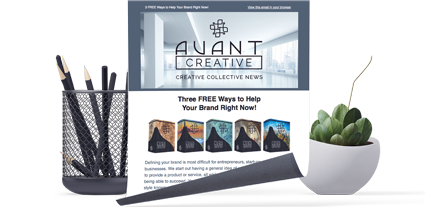The Science of Design
Good design answers questions, while great design also solves problems.
Trends shift, technology advances, but the cornerstone of design is found in science – not subjectivity.
By Merrilee Hale, Creative Director
Good design answers questions, while great design also solves problems. Trends shift, technology advances, but the cornerstone of design is found in science – not subjectivity.
The human brain processes visual information 60,000 times faster than verbal or written information, while visual information is more easily recalled. The reasons for this are found directly within the nature of auditory and visual stimuli. Visual stimuli is inherently spatial, while auditory stimuli is sequential; this is essential to note as it requires far more of our brain’s resources to recall something we have heard or read, versus something we have seen. We are consistently taking in complex visual data, which sparks the internal thought process of inner dialogue, so the information is being stored twice: once in visual code, and once in auditory code. This increases the chances that we will be able to recall visual information with proper context and accuracy.
As English speakers, we read from top to bottom, and left to right, so it makes logical sense to position graphics and images that lead us to specific information, as well as allow us to retain it. After 3 days, most people are only able to recall 10% of the information they read, where if paired with a relevant image, that number jumps to 65%. This is one of the reasons we often see a logo on a website at the top left, as opposed to the bottom right or even top right. We want our customers to recall our logo, the visual representation of our company, and position it in a memorable way that is seen as often as possible. This is also the logic behind why most websites have trended towards developing a top menu that stays positioned even when scrolling to the bottom of a page.
Positioning images, graphics, and colors effectively draws the eye and can provide emphasis on specific content that you want to make more memorable. This is particularly effective when referencing services provided or advantages in choosing your company. Repetition of colors, fonts, paragraph styling, icons, and images allows us to make valuable connections to a brand. This must be presented in a consistent, cohesive way across all media platforms and vehicles. In design, form follows function. Every piece of data, requirement, specification, and representation is just a small piece of the overarching puzzle that sets how information is presented and organized.
Creating logos and that have variation adjustments based on size and space provides versatility, while branding kits and style guides dictate how and where images, colors, and text styles should be used. Print and web media should always maintain styling aspects as similarly as possible in order to improve recall and recognition, which increases a brand’s credibility and trust. But the science of design isn’t just about hard evidence, it’s also about the context of nuanced perception such as psychology and emotion.
Psychographics, for example, is the study, classification, and market industry research of people according to behaviors, attitudes, aspirations, personality, values, and psychology; this also effects how color influences emotion, forms connections to experiences, and shapes our internal view, which is also an important consideration in determining consumer behavior – often being able to determine the “why” of how and when people buy, as opposed to demographics which explain who the buyer is. Data is important to consider but the information is limited; it doesn’t explain potential customer interests, attitudes, or motivations – which is where psychographics steps in.
Color and visual appearance have a substantial impact on consumer behavior, and contribute to 93% of a buying decision. The jury is out on colors evoking hyper-specific emotions, as there is interplay between categorical information like age, gender, education, upbringing, experiences, values; our general associations with colors, however, are evidence-based, so if design adjustments are in the future of your brand, you should consider the following signifying traits:
- Red: Excitement, Youth, strength, friendliness
- Orange: Friendliness, cheerfulness, confidence, power, forward-thinking
- Yellow: Optimism, clarity, warmth, compassion
- Green: Peace, growth, health, calm, nature/conversation
- Blue: Trust, dependability, strength, tranquility, loyalty, competance
- Purple: Creativity, imagination, wisdom, royalty
- Pink: Charming, sentimental, feminine
- Black: Strength, power, independence, security
- Brown: Ruggedness, nature/conservation
- Gray: Balance, neutrality, calm
- Silver: Elegance, glamor, fashionable
- Gold: Dominance, royalty, wealth
While certain colors’ signifying traits can be used appropriately, it all hinges on your target audience. To white-collar professionals who want to be seen as industry leaders who afford lavish lifestyles, gold may win over an account; whereas to blue-collar workers who resent the idea of royalty and luxury for those who don’t get their hands dirty, gold may in fact lose their support. A brand is more than the visual identity that represents an overall approach to design, but understanding some basic science on how we see and perceive can help build a better approach to design.
Originally published in


